News From the Festival
Prop Becomes Reality—with a Little Help from Mom
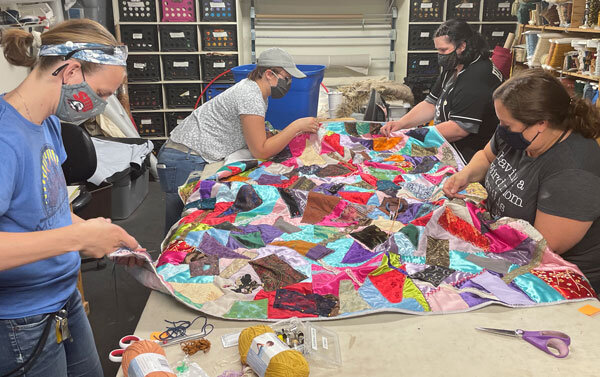
Hayley Parker (left), senior properties artisan; Ashlynd Cox, properties artisan; Ada Lauren Taylor, properties artisan; and Kelly Kreutsberg, properties supervisor.
Sometimes a prop in a play is so important to the storyline, or carries so much meaning, or is simply so intriguing that it almost becomes a character in the play. Such is the case of the crazy quilt in the Utah Shakespeare Festival’s production of Intimate Apparel: the quilt should almost be a line in the cast list, all because of Festival Properties Director Benjamin Hohman, his talented crew—and his mom.
The quilt figures prominently in the play. It is visible on Esther’s bed in many scenes. Esther has sewn the quilt over many years from scraps left from the beautiful undergarments she has made for other women. But, more importantly, she has sewn into the quilt money she has made from her sewing; it is her “bank” where she is saving to someday open her own beauty shop for black women.
So where does one turn when he needs help making a quilt? His mother, of course! Making the quilt was a major undertaking, and Hohman knew that his mother, Patricia, was an avid quilter (making dozens a year) and could take the load off his small crew by making the basic quilt.
His mother jumped at the chance, saying: “I can make a quilt, and someone else will pay for all the components? Sign me up.”
“So we had the designer choose what he thought would work as a basic color pallet and then purchased and shipped the fabrics, thread, etc. to my mom in Ohio,” said Hohman. “She then created the quilt top and mailed it back to us.”
Once the quilt top arrived and was used in a rehearsal, director Tasia A. Jones said she wanted it “way more crazy.”
“So we dug through the costume shop scrap bins and pulled a few dozen fabrics and added pieces to the quilt for about a week,” said Hohman. “Once that was done, we embellished it with multiple trims, gimps, lace edgings, etc. and then finished by hand stitching floss, yarn, and other thread-like materials in various stitching patterns over the seams.”
The “trick” of the quilt lies in the construction of pockets that appear to be sewn closed, but are actually attached with Velcro, allowing the actor to slightly “tear” the quilt to add to or retrieve the money hidden within. “We sort of ‘cheated’ when we made the base quilt,” said Hohman. “We made all the pink pieces into pockets with Velcro, so the actress could choose anywhere on the quilt, and as long as she pulled on a pink fabric panel she would find the money.”
Overall, the quilt, which is just a bit shy of a queen-size blanket, has 416 individual pieces of fabric and trim and is hand-stitched with nearly 200 feet of detailed stitching on the top. It took 160 to 180 hours of work from various artisans to create.
So, character or not, the quilt is certainly a work of art that contributes greatly to Intimate Apparel and the enjoyment of playgoers. When you see the play, Hohman and everyone involved hope you enjoy the quilt, its beauties, and its tricks. And, of course, there is one twist in the plot and surprise of the quilt we won’t even mention. No spoilers here!
The Festival’s 2021 season runs through October 9. Plays are Pericles, Richard III, The Comedy of Errors, The Pirates of Penzance, Ragtime, Cymbeline, Intimate Apparel, and The Comedy of Terrors. Tickets are available by calling 800-PLAYTIX or visiting www.bard.org.
Festival to Present Sensory-Friendly Performances

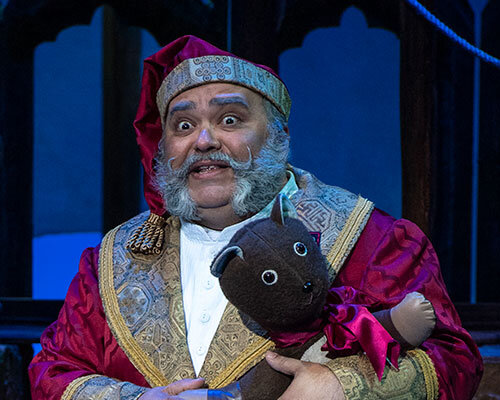
Michael Doherty as Dromio of Syracuse in The Comedy of Errors.
Richard R. Henry as Major-General Stanley in The Pirates of Penzance.
In an effort to serve those with autism spectrum disorders, sensory sensitivities, or other similar disabilities, the Utah Shakespeare Festival recently announced it will present sensory-friendly performances of two of its most popular shows.
The Comedy of Errors, the Shakespeare farce featuring two sets of twins, will be featured September 8 at 8 p.m. in the Engelstad Shakespeare Theatre. The Pirates of Penzance, a hilarious family musical, will be September 18 at 2 p.m in the Randall L. Jones Theatre.
During these special performances, patrons will be able to enjoy the show together with family and friends in a welcoming, inclusive, and relaxed space. Tickets are half-price, with some additional education and group discounts available. More information about the plays is available online at www.bard.org, but tickets must be ordered by calling the Ticket Office at 800-PLAYTIX.
“Theatre rules will be relaxed for this performance. Patrons can freely respond to the show in their own way and without judgment,” said Education Director Michael Bahr. “This is our second time undertaking this type of performance, and our patrons enjoyed it so much that we are doubling the number of performances this year.”
These changes include the following:
-
House lights will be left on slightly so patrons may see to easily move around. Some patrons may want to stand or walk a bit.
-
Playgoers will be able to engage in self-expression, singing and clapping along—or talking or making other noises.
-
Playgoers will have the freedom to take breaks during the performance; they will be welcome to come and go as needed. The cry rooms will be available to all patrons.
-
Playgoers may bring a fidget toy or other calming object.
-
Playgoers may look at phones and tablets during the performance, or they may wear headphones.
“Modifications will be environmental, not artistic, so that patrons can enjoy the same artistic product seen during other performances,” said Bahr. “However, we may decide to lower or dim any strobe lights or sudden, loud noises that could startle patrons.”
Children must be four years of age or older in order to attend this performance. Properly-worn masks are required in the Randall Theatre, but not in the Engelstad Theatre.
Take a Hike! Festival Company Favorites

Photos, left to right: The beginning of the Rattlesnake/Ashdown Gorge hike near Cedar Breaks National Monument; the Taylor Creek Trail, one of many hikes in Kolob Canyons; a slot canyon on the Kanarraville Falls Trail; Navajo Lake near the beginning point for the Cascade Falls and Virgin River Trails; and Cedar Breaks National Monument.
By Liz Armstrong
The Utah Shakespeare Festival actors and other artists love working at the Festival, but they also love their off-time, especially when they are surrounded by so many opportunities to be outdoors. Many have favorite hikes they have found in the area, and they enjoy sharing them with others, including you.
Cedar Breaks Alpine Pond Loop Trail
Actor Perry Ojeda—who appears in Pericles, Ragtime, and Richard III—claims Cedar Breaks Alpine Pond Loop Trails as one of his favorite hikes. This is also Allison Hall’s favorite hiking spots, when she isn’t working at the guest services office.
Of course, Cedar Breaks has several amazing trails. General Manager Kami Terry Paul suggests that instead of taking the trail to the two main lookout points at Cedar Breaks, you should hike the trail to the left of the main parking area to explore around the rim of the canyon.
Former Southern Utah University President and longtime Festival fan Scott L Wyatt said, “one of the most beautiful places in Utah is Cedar Breaks at sunset.” He recommends walking the trails at dusk to enjoy the striking red rock southern Utah is known for, accentuated even more by the setting sun.
Red Hollow Trailhead
Located at the base of Cedar Canyon, this trail is close and easily accessible and is one of Costume Draper Diana Girtain’s favorite hiking spots.
Located off the road to the left (if you are traveling up the canyon) there is a Red Hollow Trailhead sign next to a large tree with shoes hanging from its branches. Bring an old pair of shoes to toss up onto the tree to leave your mark, and then hike up the trail.
This trail is rather steep, so Girtain recommends wearing shoes with good tread and taking your time hiking the incline.
Ashdown Gorge Trail
Artistic Director Brian Vaughn’s hike of choice is Ashdown Gorge. The trailhead is at the Rattlesnake Trail Head along Highway 143 near Cedar Break National Monument and winds 9.5 miles, ending at Highway 14, several miles up Cedar Canyon.
“It’s a long one, but it’s definitely worth it,” Vaughn said.
Kanarraville Falls
One of the most popular hikes in the state of Utah, Kanarraville Falls is located only a short thirteen miles south of Cedar City.
Ojeda recommends this trail, as it takes you through a gorgeous red rock slot canyon. Because water runs through it, be prepared to get your shoes wet, as part of the hike requires walking through the stream. About 1.6 miles in, you will need to climb (sometimes there is a ladder) past a waterfall and continue up the trail to other waterfalls. The hike is a total of about 3.8 miles with an elevation gain of 600 feet. A permit is required for this hike; and its growing popularity has made it crowded on many days.
Kolob Canyons Trails
Kevin Davis, the Festival’s facilities director, says the trails in Kolob Canyons are some of his favorite spots.
Part of Zion National Park and with similar scenery, Kolob Canyons is a must-see area in southern Utah, and it’s located only seventeen miles south of Cedar City. One of the best hikes is a fourteen mile round-trip hike called the La Verkin Creek Trail. The trail ends at Kolob Arch, one of the largest free-standing arches in the country.
“I love Taylor Creek South Fork in Kolob. It’s a moderate hike with waterfalls, greenery and a slot canyon,” added Denise Stiegman of the guest services department.
Cascade Falls
Stiegman also recommends Cascade Falls up Cedar Canyon around Navajo Lake, saying it’s “an easy and beautiful spot,” but says to go early and finish before 10 a.m. to avoid local crowds. Cascade Falls is another one of Girtain’s favorite hikes, but the falls at the end may not be running this fall because of drought conditions.
Stiegman’s last recommendation in Cedar Canyon is the Virgin River Trail; the trailhead is located across from Cascade Falls.
“It’s about six miles and isn’t difficult but is longish. Bring a picnic and enjoy it with the squirrels, insects and horny toads,” Stiegman says. “We also have seen deer and woodpeckers on this trail.”
Jenny’s Canyon Trail (Snow Canyon)
Located fifty-eight miles southwest of Cedar City, Jenny’s Canyon Trail in Snow Canyon State Park is one of Tate Womack’s favorites. When she isn’t working in the Festival’s child care facility, she loves the area scenery, including this quick three/tenths of a mile walk through a slot canyon.
The trail includes an overlook and has climbing available on the slot canyon walls. Ideal for families and suitable for smaller children, this trail is not physically strenuous while still highlighting southern Utah’s beauty.
And, when you’re not hiking, remember the Festival’s 2021 season runs through October 9. Plays are Pericles, Richard III, The Comedy of Errors, The Pirates of Penzance, Ragtime, Cymbeline, Intimate Apparel, and The Comedy of Terrors. Tickets are available by calling 800-PLAYTIX or visiting www.bard.org.
Blog #3: Gripping the Dream

Daria Pilar Redus as Sarah in Ragtime.
By Daria Pilar Redus
Editor’s Note: This is the third in a series of blog posts from actor Daria Pilar Redus. She appeared at the Festival in 2018 in Big River and The Greenshow and this year is playing Sarah in Ragtime and Kate in The Pirates of Penzance*. She is also the recipient of the Festival’s 2021 Michael and Jan Finlayson Acting Award.*
On the way home from getting my COVID-19 vaccination last spring, I received a call that delivered some of the most terrifyingly exciting news. I’d be playing Sarah in Ragtime at the Utah Shakespeare Festival. After the initial offer, the voice on the other end of the phone was drowned out by the sound of my panicked, beating heart. I was scared. Yes, I was excited . . . but I was scared.
How am I going to tell this woman’s tragic story? How am I going to tell it well? How am I going to put myself in the shoes of a woman who did something so unforgivable? It would take a miracle.
Or maybe, it would simply take . . . me.
To me, the gift of being an actor is having the chance to examine our humanity. We have to understand why people do the things that they do and make the choices they make. As I began to do character work on Sarah, I was absolutely baffled at how many parallels I found between this genuine, kind, optimistic woman and myself. Ragtime is all about dreaming. Holding onto hope, holding on to a dream, and pursuing a dream. The dream. We’re all different, so the loss of “the dream,” whatever that may be for you, is handled and processed in different ways.
I, Daria, am a dreamer in a very similar way to Sarah. I, too, dream of the husband, the kids, sitting around drinking chocolate milk and snuggling on the hammock with the whole family. In my life, I have attached that dream to certain people. So, if someone left me, it has felt like the dream was leaving me. When someone doesn’t want me, it has felt like the dream doesn’t want me. That’s Sarah. When Coalhouse left her, it felt like the dream leaving. For Daria, that’s devastating. For Sarah, that’s devastating. Who’s to say what we all would or wouldn’t do while grieving the loss of the most important dream in our life? In pursuit of her dream, Sarah stepped completely outside of her comfort zone and invited the same person who took her dream away from her back into her life. She almost took a life while grieving the loss of the dream, and eventually died in pursuit of it.
Bridging this gap between me and Sarah wiped all of the villain, darkness, and evil out of this woman. She is completely reachable, completely human. We all have something that we’d fight our hardest for. It just so happens that mine and Sarah’s dream is the same. So, it didn’t take a miracle to tell this woman’s story. It took an examination of my heart, my desires, my faults . . . it took me.
A Family Affair
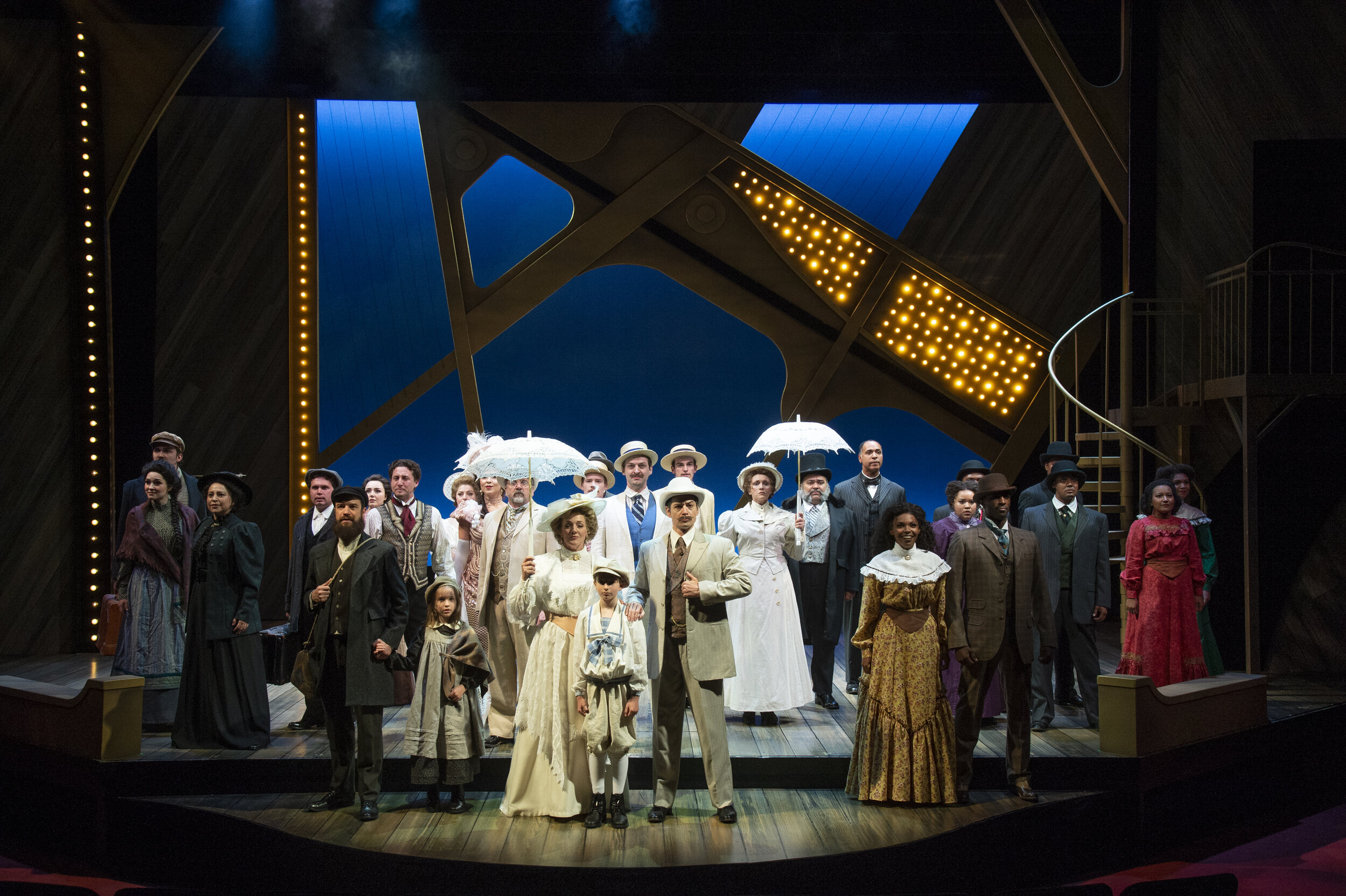
A scene from Ragtime*, with Aaron Galligan-Stierle (left front with beard) as Tateh, Zoe Galligan-Stierle (holding her father’s hand) as The Little Girl, Devin Galligan-Stierle (front center) as The Little Boy, and Shannon Galligan-Stierle, right rear, holding an umbrella) as Ensemble.*
By Liz Armstrong
Family is definitely one of the major themes of the musical Ragtime playing this summer at the Utah Shakespeare Festival. All three intertwined story lines feature families: the upper-class white New Rochelle family of Father, Mother, The Little Boy, Younger Brother, and Grandfather; the Jewish immigrant family of Tateh and his daughter, The Little Girl; and the black Harlem family of ragtime musician Coalhouse Walker Jr., Sarah, and their baby boy.
But there is also family behind the scenes—literally. All four family members of the Galligan-Stierle family are acting in Ragtime. Father Aaron Galligan-Stierle plays Tateh, Mother Shannon is in the ensemble, their nine-year-old son Devin is The Little Boy, and seven-year-old Zoe is The Little Girl.
“This was a pleasant surprise for all of us. That we could act together as a family and get back on stage,” Shannon said. “It wasn’t something we were looking for, but it was a no-brainer when the opportunity came our way.”
Aaron and Shannon started acting as children. Shannon began acting professionally with her parents and sister at the age of three, and she continued in theatre and met Aaron when they performed in The Lost Colony together in 2002.
Aaron began working at the Festival in 2004, when he was cast in Forever Plaid and My Fair Lady, while completing graduate school studies at Pennsylvania State University.
“It was a been a dream working for the Festival, where I played supporting roles, and slowly over the years got to play these larger roles like Dromio of Syracuse in The Comedy of Errors and Tateh in Ragtime,” Aaron said.
Shannon and Aaron consider the Festival their artistic home, with Aaron acting in eight seasons over the course of seventeen years during which Shannon worked in house management, the box office, and now as an actress.
“We’ve had a lovely journey with the Festival because we had a season that we were dating, the next that we were engaged, the following that we were married, and all the years we’ve been here since with kids at various ages,” Shannon said.
They even planned their wedding in Cedar City, purchasing their wedding rings from a jewelry store on Main Street, just a block away from the Festival grounds. They were married in September 2005. Both Aaron and Shannon agreed that they have a special place in their hearts for Cedar City and the Festival.
“It is so meaningful to have this experience and give the children an opportunity to work alongside a company of people who are committed, collaborative and compassionate,” Shannon said. “This cast, creative team, and crew lead with empathy and a passion for putting themselves in other’s shoes in an amazing way.”
Their journey became even more special when Brian Vaughn, the artistic director at the Festival, called and asked Aaron if he would be interested in playing Tateh in Ragtime.
Aaron immediately said yes to the role, and the stars aligned when both Brian (with a nudge from Melinda Pfundstein) and Aaron realized that his children were the perfect ages to play roles in Ragtime. Even more perfect? Shannon was eager to participate in the acting company of the Festival, and so the kids and Shannon auditioned and were ecstatic when they heard back that they all had roles in the play.
The process from auditioning for the play, rehearsing, and now performing live on stage during the 60th anniversary season went smoothly, things falling into place as if it were meant to be.
With the pandemic giving their children the option to complete the 2021 school year online, it was possible for the children to complete school from 7 a.m. to noon online and then rehearse in the afternoon and evening for the Festival.
“Their last day of school was the day before our first preview . . . if we hadn’t had that option I’m not sure if we could’ve been here,” Aaron said.
Directly after completing the season at the Festival, the Galligan-Stierle family will be moving to Pennsylvania, where Aaron recently took the position as head of musical theatre at Slippery Rock University.
“It’s been so good to watch Shannon and the kids blossom and be joyful after a year of quarantine and isolation,” Aaron said. “It’s been awesome to be a part of a community, and our kids have grown exponentially fast.”
Although it is Devin and Zoe’s first ever show, they have impressed both their parents and audience members with their performances.
“They love the musical so much, they sing it around the house. Devin is showing how consistent and committed he can be with things, and Zoe stays in character, sometimes ad-libbing secretly to Aaron on stage,” Shannon said.
Aaron said he didn’t teach Zoe to ad-lib, but that he “lost his mind” the first time she turned to him on stage and added in a line, talking to him completely in character at seven years old.
When asked what the best part of acting in Ragtime with her family was, Zoe replied that she’s happy she gets to hold her dad’s hand almost the entire show.
“I get to act with my family, and it’s nice being in the show with them,” Devin said. “And since it’s my first show ever, it’s really helpful knowing that they’re doing the same thing, and that I know they’re nearby.”
Acting as a family comes with its challenges, though, and Shannon and Aaron said getting ready to leave the house on time for shows and rehearsals is “absolute absurdity.”
However, the good far outweighs the bad, and this talented family has grown closer to each other because of the opportunity, saying there’s something special about watching each other shine.
For us? We get to see how powerful love between family members can be, and that warm feeling projects from the characters onstage and right into the hearts of the audience, adding just a little more goodness into the world.
The Festival’s 2021 season is June 21 to October 9. Plays will be Pericles, Richard III, The Comedy of Errors, The Pirates of Penzance, Ragtime, Cymbeline, Intimate Apparel, and The Comedy of Terrors. Tickets are available by calling 800-PLAYTIX or visiting www.bard.org.
Blog #2: The Contagious Heart
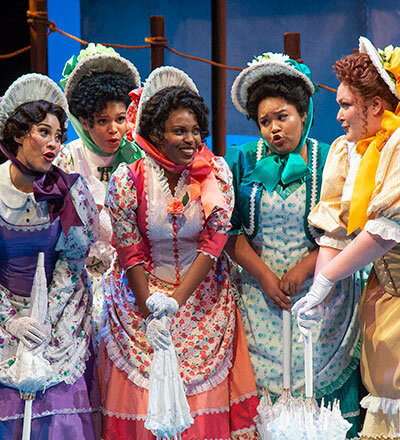
Sophia Guerrero (left) as Sister, Amara Webb as Sister, Daria Pilar Redus as Kate, Tafadzwa Diener as Sister, and Lena Conatser as Edith in The Pirates of Penzance.
By Daria Pilar Redus
Editor’s Note: This is the second in a series of blog posts from actor Daria Pilar Redus. She appeared at the Festival in 2018 inBig RiverandThe Greenshowand this year is playing Sarah inRagtimeand Kate inThe Pirates of Penzance*. She is also the recipient of the Festival’s 2021 Michael and Jan Finlayson Acting Award.*
We’ve all heard people talk about the “magic of theatre” and have certainly witnessed it first hand. I’m sure that the first time I heard this idea I was still in elementary school. Everyone who has been fortunate enough to cross paths with the Utah Shakespeare Festival has felt its magic. Of course you have; it’s inescapable. But this magic exists at theatres worldwide, not just here in Cedar City, Utah. So, what makes this theatre different from any other that I’ve had the pleasure of crossing paths with? The heart.
Every show that is put up here at the Utah Shakespeare Festival so clearly began with a desire to work, to play, to create, to dream, to invent, and to reach every heart in the company and the audience. From the powerful dramas like Ragtime, to the side-splitting comedies like The Comedy of Errors, this foundation remains the same. As an actor, I appreciate the time we dedicate right away, before ever putting the shows up on their feet, to ask the most important questions: Why are we telling this story? Why now? What do we want to say? How do we make sure we’re all telling the same story? This ensures that there is heart embedded in the show because it was instilled right off that bat.
Daily reminders of the answers to these questions keep our shows fresh, intentional, and loaded with heart. It’s always very apparent to me when these questions haven’t been asked or answered amongst a company of storytellers. The storytellers here at the Festival, including designers and everyone else here who works to fill our theatres with “the magic” and plenty of heart, are always on the same page,—which makes the theatre here unstoppable. Unmatched.
Ever since graduating from Otterbein University, I’ve wondered what keeps me coming back to theatre in general, but specifically to this festival. And I think I’ve figured it out. This truly magical theatre has helped me to answer an essential question: Why do I do theatre? After spending a couple summers in the beautiful hills of Cedar City immersed in the most fantastic theatre this country has to offer, I’ve found my answer. I do theatre in order to become a better, more empathetic person. To listen and understand the perspective of others. To educate myself on a wide variety of different human experiences. And maybe, hopefully, the audiences here will do the same. This desire to become closer to others through understanding is the contagious heart of the Festival. My hope is that with every show in every season of this festival the audiences we reach can challenge their perspectives and make more progress toward tolerance and compassion.
Singing, Dancing, and Magic!
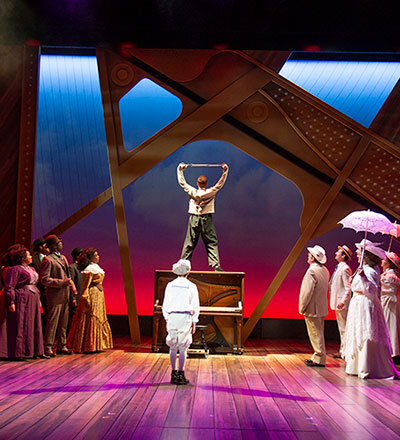
By Liz Armstrong
Actor Rhett Guter is a man of many talents. Of course, he’s a consummate actor, but (as evidenced by his performances at the Utah Shakespeare Festival this summer), he is much more. For instance, he sings and dances his way across the stage as the swashbuckling Pirate King in The Pirates of Penzance, and he choreographed The Greenshow. But what may not be as obvious is that Guter is a professional magician and uses that skill playing real-life magician Harry Houdini in Ragtime.
A southern Utah local, Guter grew up in St. George and attended Tuacahn High School for the Performing Arts where he began to study dance, music, and acting as a teenager; but what led Guter to study the performing arts was, in fact, magic.
“I got into performing arts because I started studying magic when I was about 12 years old,” Guter said. “I worked with a magician named Jeff McBride who told me that if I wanted to be a great magician, I would study what he called ‘the cousin arts.’”
Guter was the first student to graduate from the musical theatre bachelor of fine arts program at Southern Utah University and also graduated with a bachelor of science in dance.
“I worked consecutively for the Festival for about seven seasons while I was in college and then right after,” Guter said. “Then I moved to Chicago for five years and [am now] in New York City.” There he is spending half of his time acting and half of his time working as a professional musician.
When Guter heard that the Festival was producing Ragtime this season, he immediately called Artistic Director Brian Vaughn in hopes that he could play the role of Houdini and help Vaughn with the magic in the play. Vaughn agreed, and they started to work, discussing how to most effectively fold the magic into the fabric of the play.
“The tricks themselves weren’t the challenge,” Guter said. “The challenge was integrating them into the play without it stopping the story.”
Guter’s favorite trick in Ragtime is the box illusion trick in Act 2 which is called “metamorphosis.” In it, actors disappear and reappear, puzzling the audience with its convincing execution. Historically, Houdini was famous for doing that very trick with his wife, and so it was something Guter was determined to implement into the musical as a “historical nod” to the magician.
“As a professional magician I do a lot of close-up magic, [such as] sleight of hand, card tricks, coin tricks, that kind of thing,” Guter said. “You see some of that in the play, but that doesn’t read as well to a large audience.” However, Guter didn’t shy away from the challenges this alternative magic brought, leaping at the chance to experiment.
“Personally, I love the very first trick I do with the straightjacket because I designed it completely from scratch and I had no idea if it would work,” Guter said. “So whenever that trick works, it’s extra satisfying.”
For Guter, being back on stage this season has been an extraordinary experience. By blending the two things he is most passionate about—theatre and magic—Guter has been able to add his talent to the company’s arsenal and—quite literally—contribute to the magic of theatre.
Guter considers the Festival stage home, and so returning this season is a full-circle moment in the magician/actor’s life. “I learned how to perform on the Festival stage, and for me to be back home this year and share both the talents I learned here—but have grown as an artist over the last eight years—has been rewarding.”
The Festival’s 2021 season runs through October 9. Plays are Pericles, Richard III, The Comedy of Errors, The Pirates of Penzance, Ragtime, Cymbeline, Intimate Apparel, and The Comedy of Terrors. Tickets are available by calling 800-PLAYTIX or visiting www.bard.org.
Words Cubed: Announcing Two New Plays

The Utah Shakespeare Festival’s Words Cubed program for new play development is set to introduce audiences to two exciting and insightful plays this season: The Virgin Queen Entertains Her Foolwill play August 13, 14, 25, and 27. Polar Bears, Black Boys, & Prairie Fringed Orchidswill be performed August August 20, 21, 26, and 28. The staged readings begin at 9:30 a.m. in the Eileen and Allen Anes Studio Theatre. Tickets are on sale by calling 800-PLAYTIX, going in person to the Ticket Office at the Beverley Center for the Arts, or visiting www.bard.org.
“The chance to steward a process in which playwrights get to sit in a room with talented actors and insightful directors for a whole week and pick apart the beats, intentions, and particular words of a play—and change them when necessary—to develop an even stronger piece of theatre is thrilling,” said Derek Charles Livingston, director of new play development/artistic associate. “This program—Words Cubed—is a privilege and responsibility the Festival offers these works and the greater theatre world.”
Playwright Michael Hollinger introduces his play, The Virgin Queen Entertains Her Fool, with his tongue firmly in his cheek: “It’s 1570-something, in an unfamiliar European country, and Queen Adalia—mother of us all—is rapidly dying. High time to name a successor, as her presumptive heirs are both raising armies to slaughter each other and claim the throne. But the Virgin Queen blunts her pain with poppies and the entertainments of her fool. (Murder ballads! Puppets! Fart jokes!) What’s a privy councillor to do to settle the matter and save the realm? It’s a tragedy, albeit dressed in motley.”
Hollinger is a prolific and much celebrated playwright, with numerous productions around the country, off-Broadway, and abroad. Awards include a Steinberg New Play Citation from the American Theatre Critics Association, a Los Angeles Drama Critics Circle Award, four Barrymore Awards, and many others.
Playwright Vincent Terrell Durham saysPolar Bears, Black Boys, & Prairie Fringed Orchids“isan invitationto eavesdrop on a last-minute cocktail party hosted by a well-meaning white couple in their newly renovated Harlem brownstone. Molly Castle and her husband Peter have invited Jaquan, a Black Lives Matter activist; his plus-one, Shameeka; a business owner and author; and Rita Dupree, the mother of a recently slain twelve-year-old. The cocktail conversation, in ways witty and cutting, quickly gives way to the emotions and issues revealing some of the complexities of contemporary America.”
Durham is a playwright, poet, and author. Born in Binghamton, New York, he first honed his storytelling skills performing as a stand-up comic across the country. He has authored several full-length plays, as well as over thirty short plays, and numerous other works.
The staged readings of these plays will be followed by discussions between the playwright, actors, and audience members. “The post-reading discussions provide playwrights a unique opportunity to engage in dialogues with audiences about the work,” said Livingston. “In our process, the playwrights pose questions to the audience as well as listen to the feedback of these astute theatre-goers who love new work. The focus of this artist-audience interaction remains firmly fixed on the play.”
Words Cubed is designed to nurture the new work of nationally-recognized and emerging playwrights and allow them to workshop their plays in front of an audience and then receive feedback from the actors and audience.
In addition to the Words Cubed readings, tickets for the Festival’s regular season plays are also on sale. The 2021 season includes The Comedy of Errors, Pericles, Richard III, The Pirates of Penzance, Ragtime, Intimate Apparel, Cymbeline, and The Comedy of Terrors.
NOTE: The plays in this series are written for contemporary adult audiences, and some plays may contain themes and language not appropriate for children and that some may find offensive.
The Corset as Art: Past and Present

Tying in closely with the Festival’s production of Intimate Apparel, the Southern Utah Museum of Art (SUMA) is featuring the exhibition The Corset as Art: Past and Present.
The show, which is generously sponsored by Shelley Berkley and Dr. Larry Lehrner, includes numerous corsets from various eras and styles, from utilitarian to beautiful to flamboyant.
“Some of these objects display extraordinary sewing craftsmanship, but many are three-dimensional objects created from artistic minds using different methodologies to make three-dimensional art,” said guest curator Laura Crow. “One of the works is, in fact, a costume created for actress Scarlett Johansson’s appearance on Saturday Night Live and made entirely of plastic mylar.”
The Festival production of Intimate Apparel is the heart-rending yet hopeful story of Esther, an African American woman in the early 1900s that creates intricate pieces of lingerie for a wealthy clientele while also searching for love and acceptance. Written by two-time Pulitzer Prize winner Lynn Nottage and directed by actor, theatre educator, and director Tasia A. Jones, Intimate Apparel explores social divisions of race, religion, equality, class, and sexism.
“I was thrilled when Frank Mack, executive producer of the Festival, approached me about the play and partnership,” said Jessica Kinsey, executive director of SUMA. “As the art museum at the Beverley Center for the Arts, this is a great example of how we can bring the performing and visual arts together.”
“This is the perfect companion piece to our highly-acclaimed production of Intimate Apparel,” added Donn Jersey, Festival director of development and communication. “Watch the play then visit the museum and learn about the corsets and the cottage industries that the play depicts.”
SUMA is located on the northwest corner of the Beverley Center for the Arts, just steps from the Festival theatres. Hours are Monday through Saturday from 11 a.m. to 6 p.m. For more information on SUMA, visit www.suu.edu/suma.
The Festival’s 2021 season continues through October 9. Plays arePericles, Richard III, The Comedy of Errors, The Pirates of Penzance, Ragtime, Cymbeline, Intimate Apparel,andThe Comedy of Terrors. Tickets are available by calling 800-PLAYTIX or visiting www.bard.org.
Blog #1: It's Magic!

By Daria Pilar Redus
Editor’s Note: This is the first in a series of blog posts from actor Daria Pilar Redus. A graduate of Otterbein University, she appeared at the Festival in 2018 inBig RiverandThe Greenshowand this year is playing Sarah inRagtimeand Kate inThe Pirates of Penzance*. She is also the recipient of the Festival’s 2021 Michael and Jan Finlayson Acting Award.*
In 2017, I carefully selected my audition materials for the Utah Shakespeare Festival’s summer season. I was confident that I had a good chance of getting a spot at this festival that my university had a long-standing relationship with. The juniors at Otterbein University are encouraged to submit for the Festival’s summer season upon returning to school every year. But in my junior year, nothing came of it. I wasn’t defeated, I just knew that I had to be patient and wait for my cards to play out as they were meant to. It was only a matter of time before I’d get my chance to work at this festival—a festival that I wanted to be a part of so desperately, but couldn’t articulate a single reason why.
Fast forward, one year later, I was the only senior at Otterbein that insisted on having one more chance to shoot my shot with the Festival. There was such an overwhelming magnetic pull to this festival out in Utah that I felt so intensely before ever knowing a single thing about it. I got a song, monologue, and dance filmed, submitted my tape, and found out that I’d be joining the company in 2018 for its summer season. I was over the moon. I was so excited for my first professional gig out of college. But it felt deeper than that. It felt so intentional, and I had no clue why. Then, I showed up. Then, I knew.
It started as early as the flight into town. The breathtaking mountains of the West were miracles that I’d never seen before, and I couldn’t believe that I was still in America. I’d been so ignorant all my life, not knowing that anything so beautiful even existed. As I got off the shuttle into Cedar City, I noticed that this pocket-sized city was hugged by these stunning red rocks from every corner. The beauty was inescapable. I couldn’t walk out of my housing at the Festival, walk to the Pastry Pub, or even push a shopping cart out of Walmart without the mountains reminding me that I was so far from home, and yet I’d never been closer. I was spectacularly overwhelmed with the all-round beauty of this new adventure without even entering a day of work yet. Then, rehearsals began.
Magic is real. I’m not certain whether it’s real in all forms, or in the way we often see on television or in magic shows with card tricks and disappearing coins. But magic exists, and it roams the halls of the Randall Theatre, hides in the wings of the Englestad Theatre, sits in row B at the Anes Theatre. I was first introduced to its enchanting presence on the first day of rehearsal for both The Merry Wives of Windsor and Big River, and it’s followed me ever since. I’ve also learned that magic and heart are dear friends, and here at the Festival, they coexist. One wraps tightly around the other’s hand, and they travel together, infecting everyone that passes through this festival—audience members, sound technicians, actors, administrators. Me.
Read Blog Post #2 | Read Blog Post #3 | Read Blog Post #4


